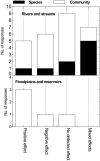The Influence of Forests on Freshwater Fish in the Tropics: A Systematic Review
- PMID: 32440023
- PMCID: PMC7231604
- DOI: 10.1093/biosci/biaa021
The Influence of Forests on Freshwater Fish in the Tropics: A Systematic Review
Abstract
Tropical forests influence freshwater fish through multiple pathways, only some of which are well documented. We systematically reviewed the literature to assess the current state of knowledge on forests and freshwater fish in the tropics. The existing evidence is mostly concentrated in the neotropics. The majority of studies provided evidence that fish diversity was higher where there was more forest cover; this was related to the greater heterogeneity of resources in forested environments that could support a wider range of species. Studies quantifying fish abundance (or biomass) showed mixed relationships with forest cover, depending on species-specific habitat preferences. We identify the key challenges limiting our current understanding of the forest-fish nexus and provide recommendations for future research to address these knowledge gaps. A clear understanding of the functional pathways in forest-freshwater ecosystems can improve evidence-based policy development concerned with deforestation, biodiversity conservation, and food insecurity in the tropics.
Keywords: conservation management; ecosystem function; functional diversity; inland; land use.
© The Author(s) 2020. Published by Oxford University Press on behalf of the American Institute of Biological Sciences.
Figures




References
-
- Abdul Hamid S, Md Rawi CS. 2011. Influence of substrate embeddedness and canopy cover on the distribution of Ephemeroptera, Plecoptera and Trichoptera (EPT) in tropical rivers. Aquatic insects 33: 281–292.
-
- Abes SD, Agostinho AA.. 2001. Spatial patterns in fish distributions and structure of the ichthyocenosis in the Agua Nanci stream, upper Parana River basin, Brazil. Hydrobiologia 445: 217–227.
-
- Agostinho AA, Zalewski M.. 1995. The dependence of fish community structure and dynamics on floodplain and riparian ecotone zone in Parana River, Brazil. Hydrobiologia 303: 141–148.
-
- Aleman JC, Jarzyna MA, Staver AC. 2018. Forest extent and deforestation in tropical Africa since 1900. Nature Ecology and Evolution 2: 26–33. - PubMed
-
- Allan JD. 2004. Landscapes and riverscapes: The influence of land use on stream ecosystems. Annual Review of Ecology Evolution and Systematics 35: 257–284.

